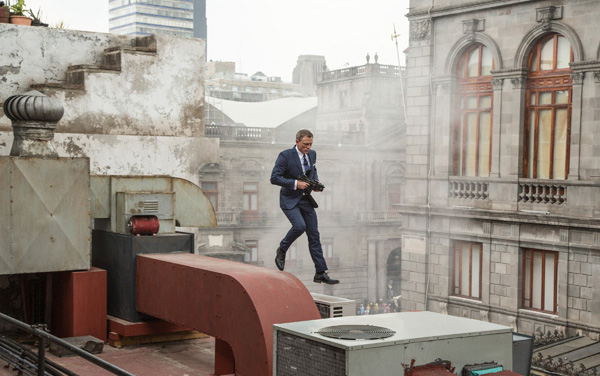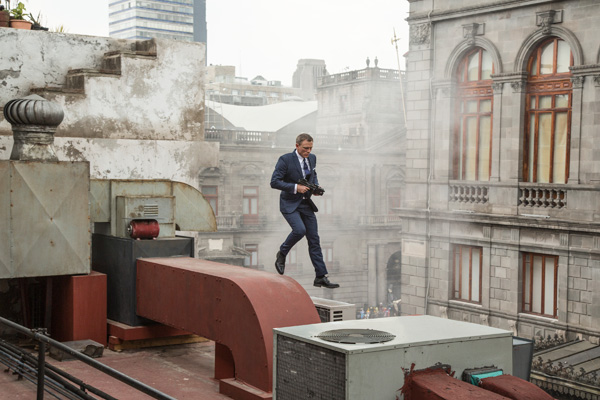IO Entertainment worked with director Sam Mendes, DP Hoyte van Hoytema 
and crews working on VFX, SFX, production design, art, stunts and locations,
as sole previs provider on ‘Spectre’.
IO Entertainment’s Previs Goes Undercover for ‘Spectre’ |
|
IO Entertainment was the sole previs provider for the new James Bond film ‘Spectre’, working with Sam Mendes, cinematographer Hoyte van Hoytema and the crews working on visual effects, special effects, production design, art, stunts and locations. The IO Entertainment previs team came on board during pre-production, about five months prior to the start of principal photography, and stayed on for almost a year, wrapping a few weeks before the end of shooting. The team is based at Pinewood Studios, well-placed to help the production visualise and pre-plan major sequences, in terms of looks, action and approaches to shooting. |
 |
|
Sequence BlueprintsThe technique involved recreating the locations for these sequences in 3D, animating the action and matching the results against virtual versions of camera lenses and camera rig movement, giving the production a clear idea of how sequences might look. The resulting information also helped them establish sequence blueprints - that is, identify constraints, safety requirements, required permissions, design details and changes, as well as what would have to be carried out in post. For extensive work like this that depends on accuracy, reference material for the environment builds is a critical factor. IO Entertainment company director Brad Blackbourn said, “We are source agnostic for our reference material, as we have very limited time and usually start so early in the process that we're building locations that no one on the project has visited yet. Sometimes we start before an actual location even exists. “We gather data for environments from various sources, such as any available SketchUp models from the Art Department, cross referenced with information from Google Earth. We might also derive approximate 3D reconstructions from photography captured during early technical investigations. |
 |
|
IO Entertainment previsualised the movie's boat chase on the Thames. |
|
Interactive ExplorationFor CG previs, IO base most of their assets in Maya. Depending on how the previs will be reviewed, they will animate, render and edit together QuickTime movies of the entire sequence from multiple cameras inside Maya, or they may shift the sequence into a game engine to allow a more interactive, exploratory approach. They also have a proprietary virtual camera system that runs on a tablet device. This allows the DP, director or production designer to ‘walk’ through the virtual set/location while the tablet acts as a virtual camera through which they can view the scene, identify the location of key camera positions that would require access permission, change lenses, explore camera moves and other customisation. Over the course of the production, the team output numerous hand-offs in a range of formats. QuickTime movies of potential shots were created, and more QuickTimes from witness cameras that showed the staging, camera equipment and vehicles for shots or entire sequences. They also produced annotated screengrabs of physical set builds and stunt rigs, physical dimensions and pivot points of collapsing set pieces for SFX, many top-down plans of set orientations in sound stages, the plans of all camera positions and vehicle movements for action sequences. |
 |
|
Team Work“We had one of the most collaborative experiences we've ever had while working on Spectre. This meant that members of all departments could talk to us regarding questions they had on the specific sequences we were exploring. We were able to re-purpose work that we might be preparing for one department - VFX for instance - and with a tweak or new camera angle and some annotations, we could supply material suitable for the locations crew that they could use to obtain clearances, or the camera department could work out if they would have enough tracking gear available in Mexico or need to ship extra.” While the previs team helped choreograph complex action with possible camera coverage, again, they worked across a range of departments. Work with stunt and aerial supervisors helped identify possible stunts at altitude and establish speeds and safety distances of hero and camera vehicles. Then, with the art department, their previs helped determine the builds needed for the sound stage and backlot, and also helped establish equipment and facilities requirements. Movie Makers“From the beginning, we were working continuously with both VFX supervisor Steve Begg and SFX supervisor, Chris Corbould. One of the key questions we focused on for every sequence was whether or not an effect could be done practically - either on-set or in SFX element plates - or was best done in post,” Brad said. For example, they helped identify the size and choreography of pyrotechnics for the on-screen explosions. |
 |
|
IO Entertainment worked in detail with the cinematographer Hoyte van Hoytema and his camera crew. Early on they discussed possible camera options with Hoyte and set up virtual versions of the several cameras he was testing – in fact, very early previs was done with an IMAX camera. They also discussed his lens preferences. For example, on the 4-perf Super 35 setup he preferred the feel of the 28mm, and this became their default lens whenever possible. Concussive SymphonyWhen planning the destruction of Oberhauser's desert lair, the integration between VFX and SFX was crucial, so also was their joint passion for blowing things up - not with simulations but with real explosives. Having dissected the components of the selects Chris would shoot small tests of possible components. IO would then put footage of the explosion on cards and insert them into our 3D set of the desert lair. |
 |
|
Day of the DeadBrad described the film’s opening sequence, unforlding amid the Day of the Dead parade in Mexico City, as a massive technical and logistical challenge on set. Working across the production, the previs team pieced together how it could be achieved and what staging, choreography, equipment and set-builds were needed. “After hundreds of iterations we worked out how to get the shot, which involved a complete build-over of the rooftops of several buildings in Mexico City to make it possible for the Technocrane to track alongside Bond as he ran above crowds almost 100ft below,” Brad said. “When exploring the complex choreography of the shots, we locked our virtual Super 35 camera onto a virtual 50ft Super Techno to work out the staging of both of the tracking shots, the street parade and the rooftop. Once Sam Mendes was happy with the general look of the shot, we drilled into the technical aspects, such as physical clearances and obstacles on location. |
 |
|
“For the collapsing building in this sequence, we focused on working with Chris Corbould for a while in order to nail down what he could build, rig and collapse safely in the Pinewood backlot. After that, we worked more with Steve Begg and Associate VFX supervisor Andrew Whitehurst to focus on the collapsing façade elements that would be added later in post.” Helicopter BattleFor the complex aerial helicopter battle over the Zocalo, also in Mexico City, the production needed to find a way for stunts to be performed on location with a helicopter looping, rolling and flipping just metres above the 16th century cathedral and the National Palace, dodging a 100ft-high flagpole and then swooping below roof height in the narrow side streets. “We got everyone together with a large toy helicopter and a whiteboard to scribble notes and diagrams,” said Brad. We'd hash out everyone's suggestions and constraints while passing around the toy chopper for impromptu demonstrations. We also encouraged all the departments to share any of their exploratory material to see if we could incorporate it, or at least incorporate their intentions. |
 |
|
Once Sam was satisfied, they broke the sequence down into individual shots, exploring several different lenses and dozens of virtual camera positions both on the ground and on various buildings to isolate the ideal angles. From the selects, they prepared maps, accurate to within 12 inches of all required camera locations, allowing the locations crew to arrange access. Breakdowns of bearings, speed and altitudes for both the hero helicopter and camera helicopter were also produced and used to work out which shots and stunts could be done in the physical location. ioent.net |


















